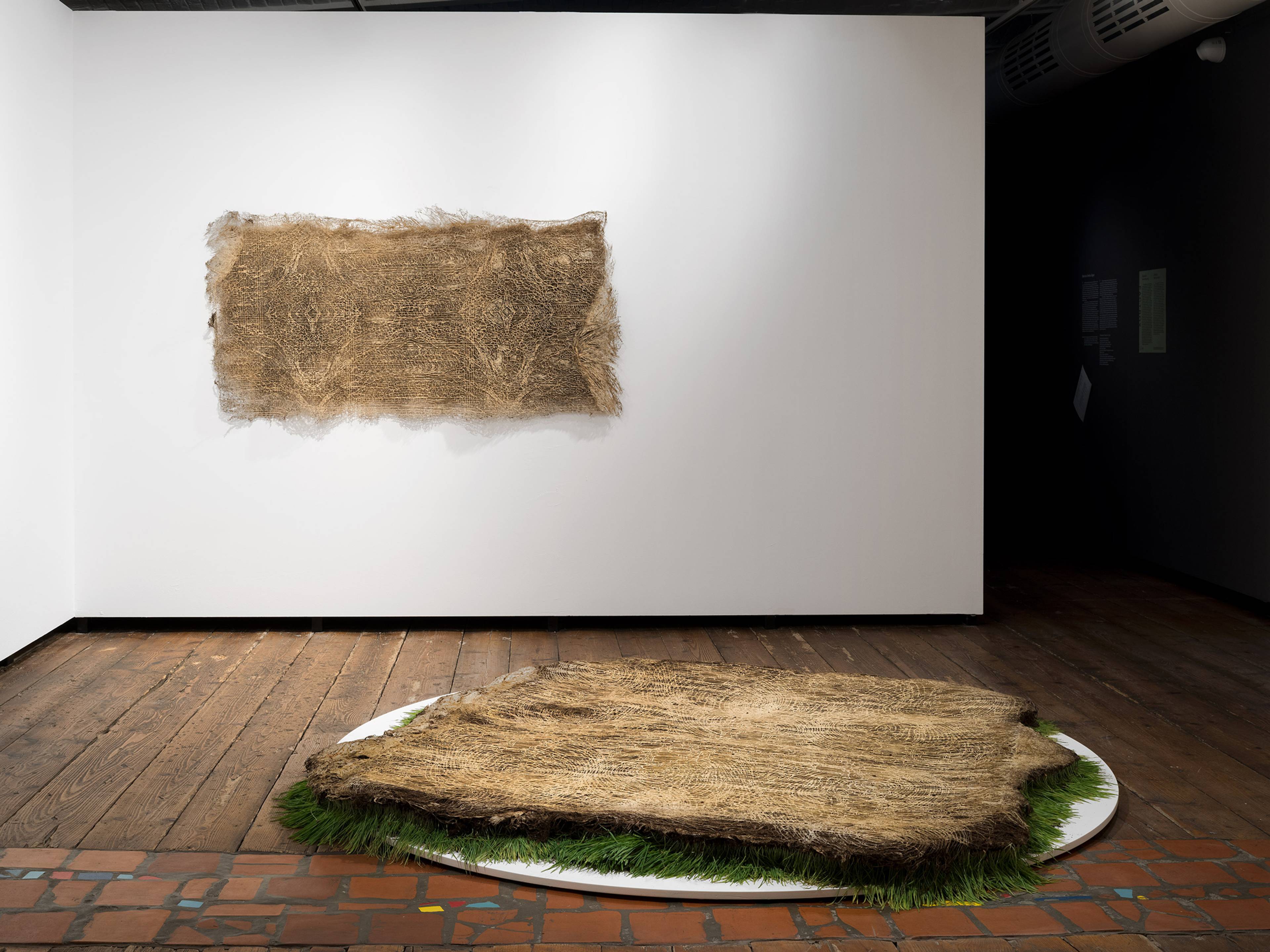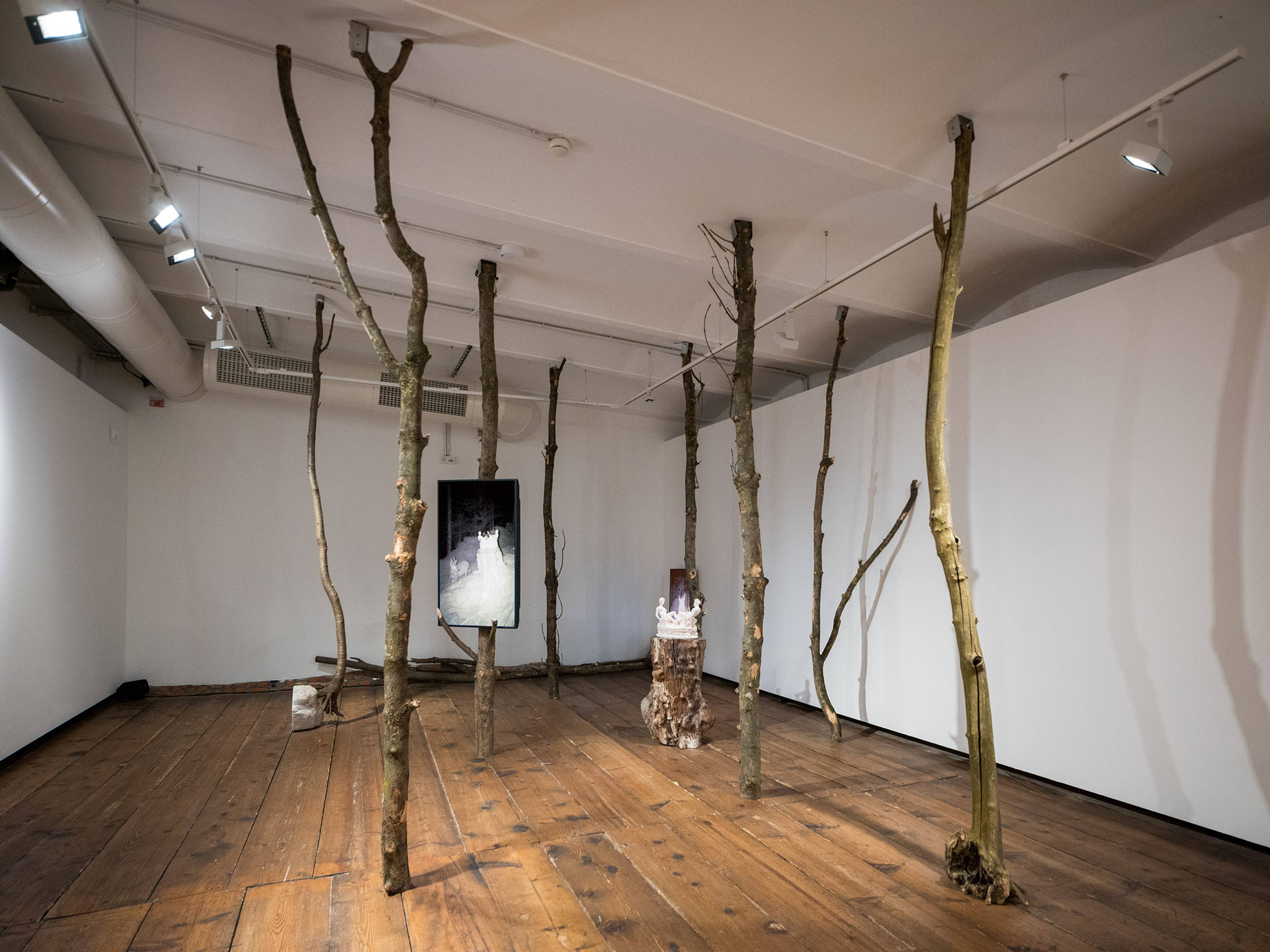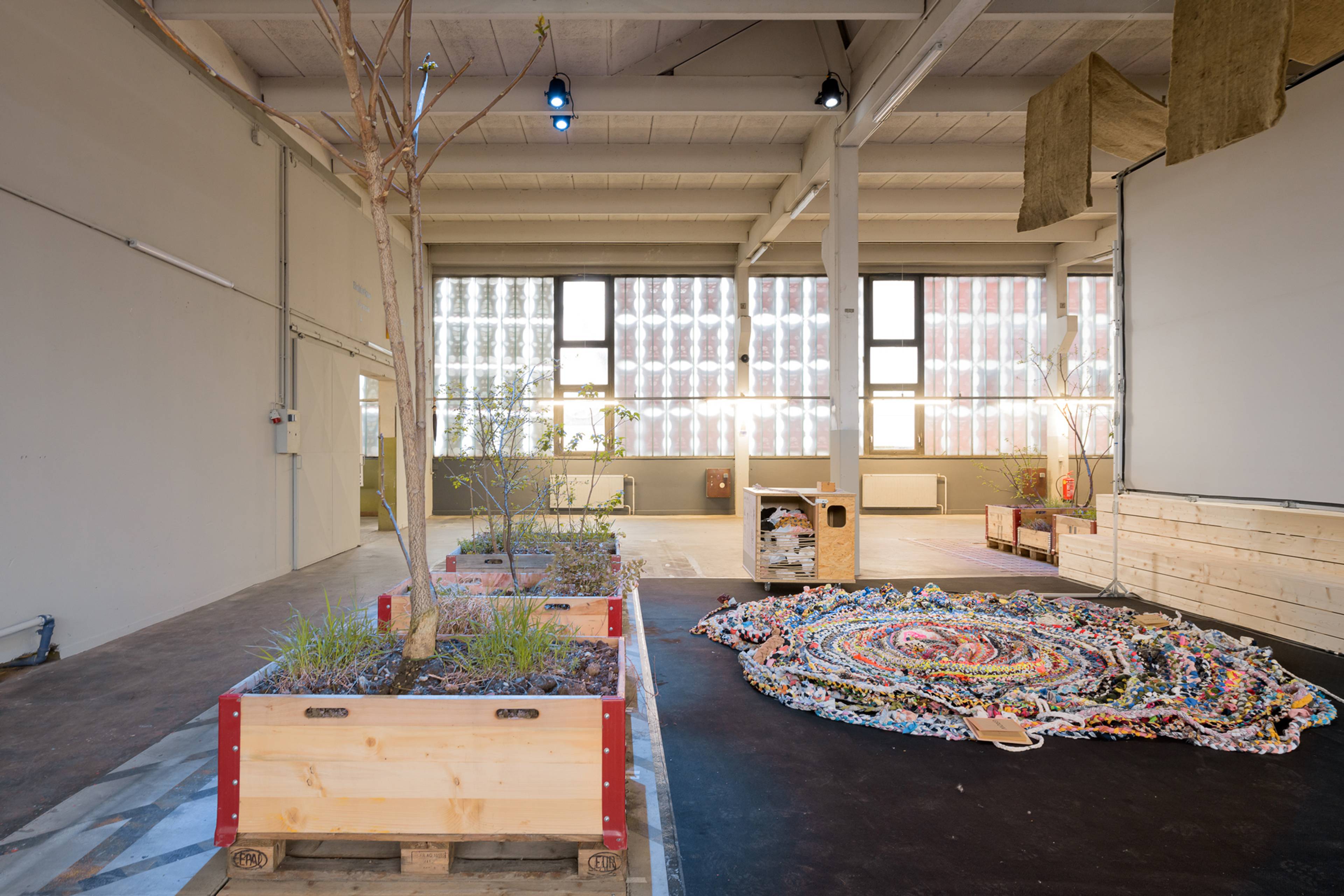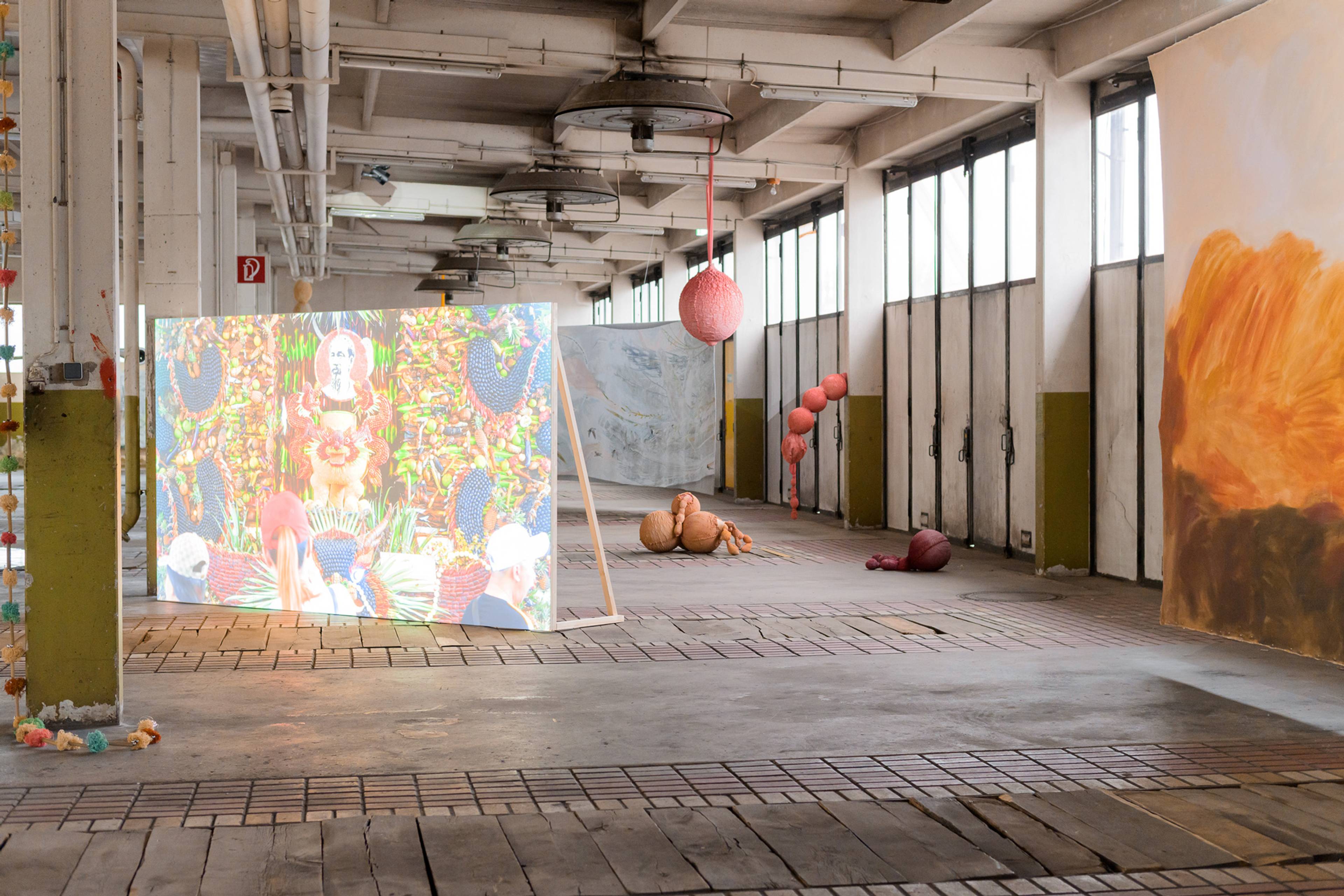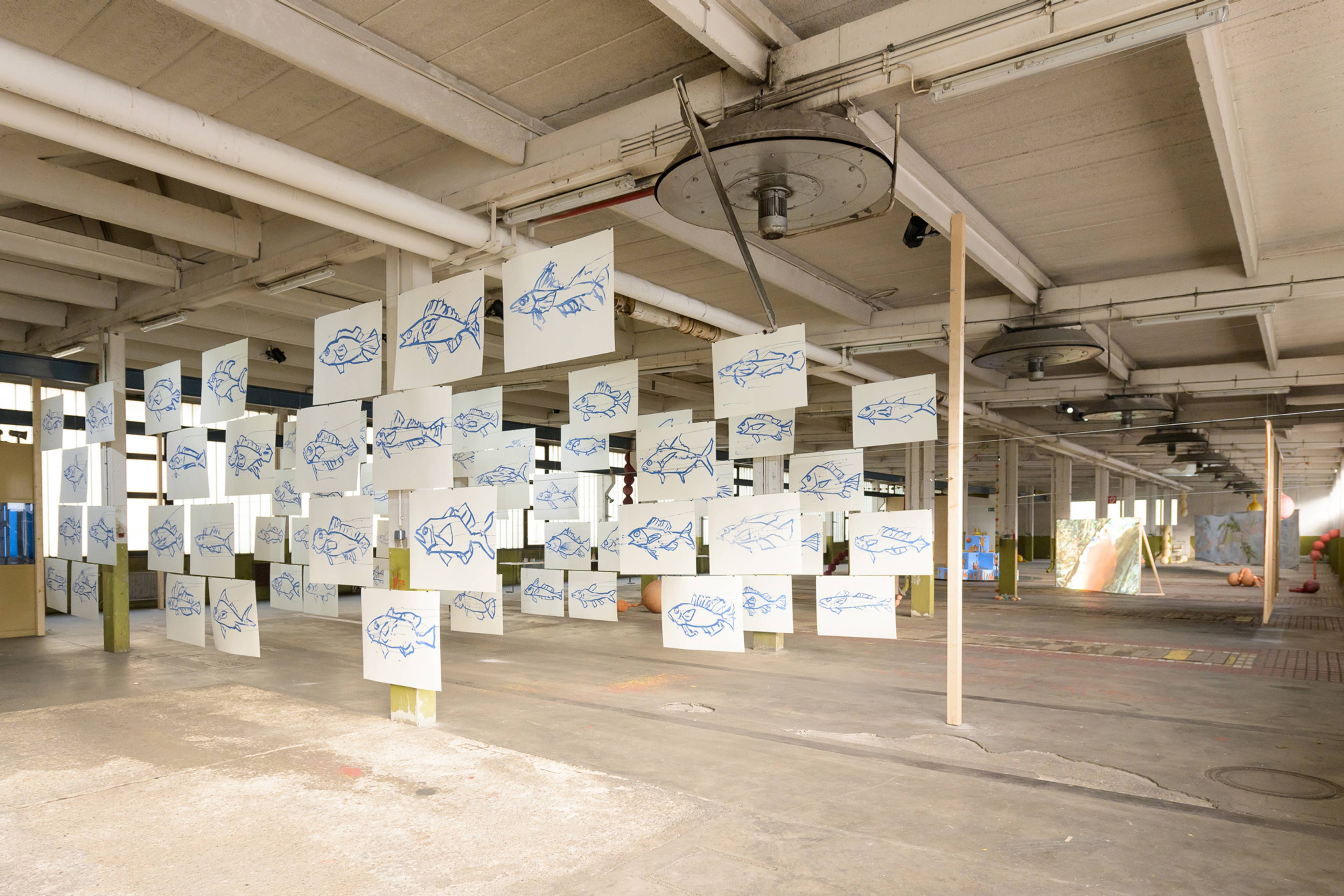In 2009, McDonald’s changed the backdrop of their logo in Europe from bright red to dark green, apparently to appeal to its customers’ environmental sensibilities. Fifteen years later, the main exhibition of the first Klima Biennale Wien opened with earthy tones and wooden interiors, valued for their calming effect on consumers and instant upmarket optics, no less in art installations than in fast-food restaurants.
For “Into the Woods,” the Biennale’s central exhibition at KunstHausWien, in-house curator Sophie Haslinger has assembled sixteen contemporary positions that thematize one of the world’s most important ecosystems: the forest. Its sensory experience is imparted through inconspicuous incense sticks “translating” the scents of two arboreal biomes (Katie Paterson), woven carpet patterns made of root networks (Diana Scherer), and an archive of seeds collected in Mason jars at Danube-Auen, a floodplain extending east of the city (Isa Klee). Woodlands’ regenerative qualities, meanwhile, are portrayed in a levitating VR experience of datified photosynthetic activity in the Swiss Alps (Rasa Šmite and Raitis Šmits) and meter-long, acid-colored, aerial photographs of a wasted rainforest (Richard Mosse).
Front left: Richard Mosse, Senador Porfírio, Pará, 2021; back: Abel Rodriguez, El árbol de la vida y la abundacia, 2019 and Tierra Firme II, 2018. Installation view, Kunst Haus Wien, Vienna, as part of Klima Biennale Wien, 2024. Photo: © Rudolf Strobl
Diane Scherer, Hyper Rhizome 14, 2024 and Interwoven, 2015. Installation view, Kunst Haus Wien, Vienna, as part of Klima Biennale Wien, 2024. Photo: © Rudolf Strobl
Such artistic strategies, whether utilizing new technologies or blunter means to extract nature’s beauty, are an epistemological inheritance of settler colonialism’s imaging and cataloguing procedures. Only occasionally disrupted by indigenous conceptions of nature, “Into the Woods” disregards the intricacies of the Western division of Nature from Culture and instead fosters a harmlessly pensive atmosphere. In this, the installation not only showcases shallow artworks, but also ducks the truly challenging question: What is the role of contemporary art amid unfolding ecocide? If incorporating climate-friendly processes in the curatorial, organizational, and logistical realization of the exhibition at KunstHausWien – by avoiding long transport routes, reducing architectural installations, and using recyclable materials – is a commendable and necessary effort for any cultural institution in 2024, its language of corporate social responsibility remains a woefully insufficient answer for the progressive potential of art.
Next to Antje Majewski’s paintings and Susanne Kriemann’s silkscreens, Anca Benera and Arnold Estefán’s installation UnWorlding (2024) is one of the few works that manages to intersperse the symbolic spheres of art and ecology without collapsing one into the other. Here, Benvenuto Cellini’s Saliera (1540–43), an elaborate salt cellar with juxtaposed allegories of Earth and Sea that was stolen in 2003 from the Kunsthistorisches Museum and later retrieved in a forest in Lower Austria, is recast as an actual salt block and once again placed in the woods, where it dissolves on animal tongues and in other exposing elements. Here, the salt version is displayed in a makeshift forest that visitors can wander through, no different from the deer in the adjoining video documentation.
Anca Benera & Arnold Estefán, UnWorlding, 2024. Installation view, Kunst Haus Wien, Vienna, as part of Klima Biennale Wien, 2024. Photo: © Rudolf Strobl
From KunstHausWien, the Klima Biennale sprawls over the city, attaching its catchy CI (a temperature map on red alert) to countless shows, events, and initiatives until mid-July: the “Aktivismus Camp” at Volkskundesmuseum, in cooperation with Wiener Festwochen; the essayistic group show “Genossin Sonne” (Comrade Sun) at Kunsthalle Wien; and the solo shows of Austrian artists Angelika Loderer and Oliver Ressler at Belvedere 21 are but a few high-profile examples. To pool all these endeavors might have lent visibility to smaller, lasting, local initiatives and created a discursive or even political momentum in the city. Unfortunately, such potentials are thwarted by not only by the Biennale’s dizzying program, but also its very framework. Based on the Vienna Biennale for Change (2021, 2019), which itself followed the Vienna Biennale (2017, 2015), both initiated at the time by MAK, the Klima Biennale is the third attempt at rebranding the format with a new marketing scheme – and people are confused.
The Nordwestbahnhof area, the last urban development project in the inner city, houses many of the Biennale’s cooperation projects, two curated group shows, and “a large experimental field for sustainable co-existence and a livable future” – picture torn up asphalt, newly planted trees, and design interventions that, sponsored by finance firms, display plant pots and phrases like “Growing your own food is like printing your own money.” A few people sit on discarded school chairs in the café; some participate in a collaborative knitting workshop.
Interior view of the Festivalareal Nordwestbahnhof, Vienna, with work by Common Ground Group / University for Applied Arts, Vienna, Klasse für Alle, as part of Klima Biennale Wien, 2024. Photo: © eSeLat_JoannaPianka
The belt stanchions that fence off the pathway to the group exhibition “Songs for the Changing Seasons,” curated by biennial-tested Lucia Pietroiusti and Filipa Ramos, read “Why be an artist when you can be an ecologist?” A provocative question that the thirteen exhibited works mutely reject. Instead, they engage in lyrical and formal gestures of love, attention, repair, and grief in the face of ecological collapse. Cooking Sections’ minimalist audio installation on the life cycle of farmed salmon and Adrián Villar Rojas’s durational video, which soundtracks silent webcam footage of animals in captivity, create a momentary feeling of urgency. Whereas Joan Jonas’s blue fish drawings and Lin May Saeed’s styrofoam reliefs, backdropped by the industrial railway station, are no more than a pleasure to look at.
Taken literally, it’s hard not to uprate the interventionist potential of an ecologist over that of an artist when art is reduced, on the one side, to its mere applicability as a communication or design tool to disseminate environmental thought and, on the other, to a shrine of subjective experience of the present. What the phrase assumedly is truly getting at – how to organize a cultural event of this scale and reflect ecological considerations in concrete production and administration processes as much as the artworks presented – is a relevant and reputable question put forward by the Klima Biennale, as the art-world circus moves on from Venice. But consolidating climate action and contemporary art runs the risk of emptying out the critical potential of both undertakings. Then again, what is founding a biennal these days but a global marketing strategy?
Left: Phan Thảo Nguyên, Becoming Alluvium & Ode to the Margins, 2019; right: Dominique Knowles, Morning Pasture, 2020; hanging and standing objects: Eva Fàbregas, Exudates, 2024. Installation view, Festivalareal Nordwestbahnhof, Vienna, as part of Klima Biennale Wien, 2024. Photo: © eSeLat_JoannaPianka
Joan Jonas, “they came to us without a word II,” 2013–23. Installation view, Festivalareal Nordwestbahnhof, Vienna, as part of Klima Biennale Wien, 2024. Photo: © eSeLat_JoannaPianka
___
Klima Biennale Wien
Various Venues, Vienna
5 Apr – 14 Jul 2024




